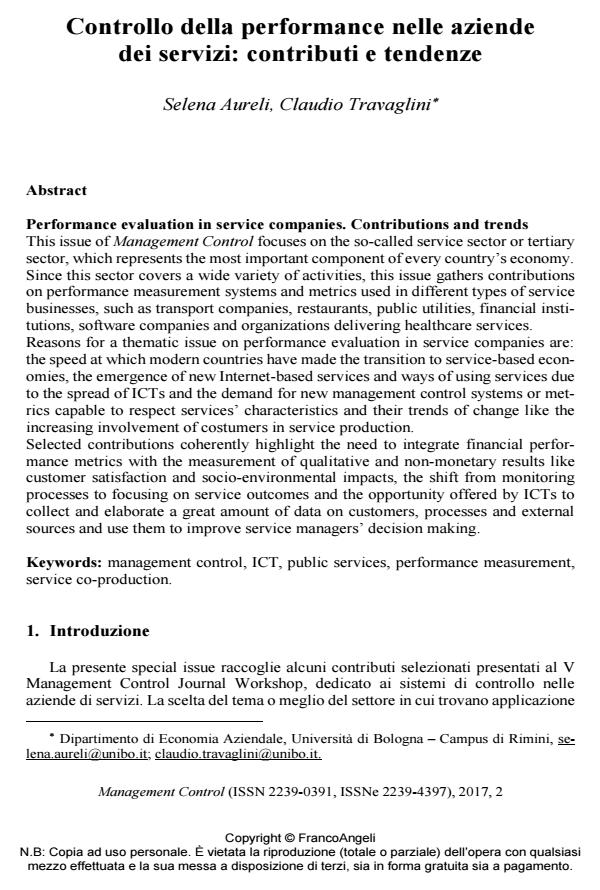Performance evaluation in service companies. Contributions and trends
Journal title MANAGEMENT CONTROL
Author/s Selena Aureli, Claudio Travaglini
Publishing Year 2017 Issue 2017/2 Language Italian
Pages 8 P. 5-12 File size 248 KB
DOI 10.3280/MACO2017-002001
DOI is like a bar code for intellectual property: to have more infomation
click here

FrancoAngeli is member of Publishers International Linking Association, Inc (PILA), a not-for-profit association which run the CrossRef service enabling links to and from online scholarly content.
This issue of Management Control focuses on the socalled service sector or tertiary sector, which represents the most important component of every country’s economy. Since this sector covers a wide variety of activities, this issue gathers contributions on performance measurement systems and metrics used in different types of service businesses, such as transport companies, restaurants, public utilities, financial institutions, software companies and organizations delivering healthcare services. Reasons for a thematic issue on performance evaluation in service companies are: the speed at which modern countries have made the transition to servicebased economies, the emergence of new Internet-based services and ways of using ser-vices due to the spread of ICTs and the demand for new management control systems or metrics capable to respect services’ characteristics and their trends of change like the increasing involvement of costumers in service production. Selected contributions coherently highlight the need to integrate financial performance metrics with the measurement of qualitative and non-monetary results like customer satisfaction and socio-environmental impacts, the shift from monitoring processes to focusing on service outcomes and the opportunity offered by ICTs to collect and elaborate a great amount of data on customers, processes and external sources and use them to improve service managers’ decision making.
Keywords: Management control, ICT, public services, performance measurement, service co-production.
- Anessi-Pessina E. e Steccolini I. (2005), Evolutions and Limits of New Public Management-Inspired Budgeting Practices in Italian Local Governments, Public Budgeting & Finance, 25(2), pp. 1-14.
- Anxo D. e Storrie D. (a cura di) (2001), The job creation potential of the service sector in Europe. Final Report 2000, Employment Observatory Research Network, Luxembourg, European Commission.
- Aureli S. e Salvatori F. (2013), Investigation of risk management and risk disclosure practices of Italian listed local utilities, Financial Reporting, Vol. 1.
- Auzar S.M., Langfield-Smith K. (2005), The effect of service process type, business strategy and life cycle stage on bureaucratic MCS in service organizations, Management Accounting Research, p. 339-421.
- Caldarelli A., Ferri L., Maffei M. (2016), I rischi derivanti dall’implementazione del cloud computing: un’indagine empirica nelle PMI italiane, Management Control, vol. 3, p. 27-48. DOI: 10.3280/MACO2016-003003
- Ellram L.M. (1993), Total cost of ownership: elements and implementation, International Journal of Purchasing and Materials Management, 29(4), p. 3-10.
- Gatti M. (2011), Gli strumenti di controllo orientate al cliente: un’analisi sistemica, Management Control, vol. 1, p. 99-124. DOI: 10.3280/MACO2011-001005
- Holtgrewe U. (2015), Services research along the service process: An overview study to support UNI Europa’s services policy project, Forba --(www.forba.at), Vienna.
- Hood C. (1995), The “New Public Management” in the 1980s: variations on a theme, Accounting, Organizations and Society, 20, pp. 93-109. DOI: 10.1016/0361-3682(93)E0001-W
- Hood C. e Peters G. (2004), The Middle Aging Of New Public Management: Into The Age Of Paradox?, Journal Of Public Administration Research And Theory, 14(3), pp. 267- 282.
- Hyvönen T., Järvinen J., Pellinen J., Rahko T. (2009), Institutional Logics, ICT and Stability of Management Accounting, European Accounting Review, 18(2), p. 241-275. DOI: 10.1080/09638180802681511
- Marchi L. (2014), Nuove prospettive di valutazione delle performance nelle aziende di servizi, Management Control, 1, pp. 5-8. DOI: 10.3280/MACO2014-001001
- Meijer A.J. (2012), Co-production in an Information Age: Individual and Community Engagement Supported by New Media, Voluntas, 23(4), pp. 1156-1172.
- Model S. (1996), Management Accounting and Control in Services: structural and behavioural perspectives, International Journal of Service Industry Management, 12(5), p. 451-475. DOI: 10.1108/09564239610113479
- Neely A. (2008), Exploring the financial consequences of the servitization of manufacturing, Operations Management Research, vol. 1, N. 2, p. 103-118.
- Palumbo R. (2015), Una contestualizzazione del concetto di co-produzione al caso dei servizi pubblici: una rassegna critica della letteratura internazionale, Azienda Pubblica, 2, pp.137-161.
- Tenucci A., Barontini R., Cinquini L. e Giannetti R. (2013), Models of performance and value measurement in service system”, in Cinquini L., Di Minin A. e Varaldo R. (a cura di), New Business Models and Value Creation: A Service Science Perspective, Milano, Springer, pp. 105-125.
- Travaglini C. (1996), Un metodo innovativo per la determinazione di prezzi e le valutazioni di redditività per i servizi turistici, in L'innovazione nell'economia delle aziende, Napoli, Edizioni Scientifiche Italiane.
- Vargo S.P., Lusch R.F. (2008), From goods to service(s): divergences and convergences of logics, Industrial Marketing Management, p. 254-259.
- World Economic Forum (2009), The Global Competitiveness Report 2009–2010, Geneva.
Selena Aureli, Claudio Travaglini, Controllo della performance nelle aziende dei servizi: contributi e tendenze in "MANAGEMENT CONTROL" 2/2017, pp 5-12, DOI: 10.3280/MACO2017-002001